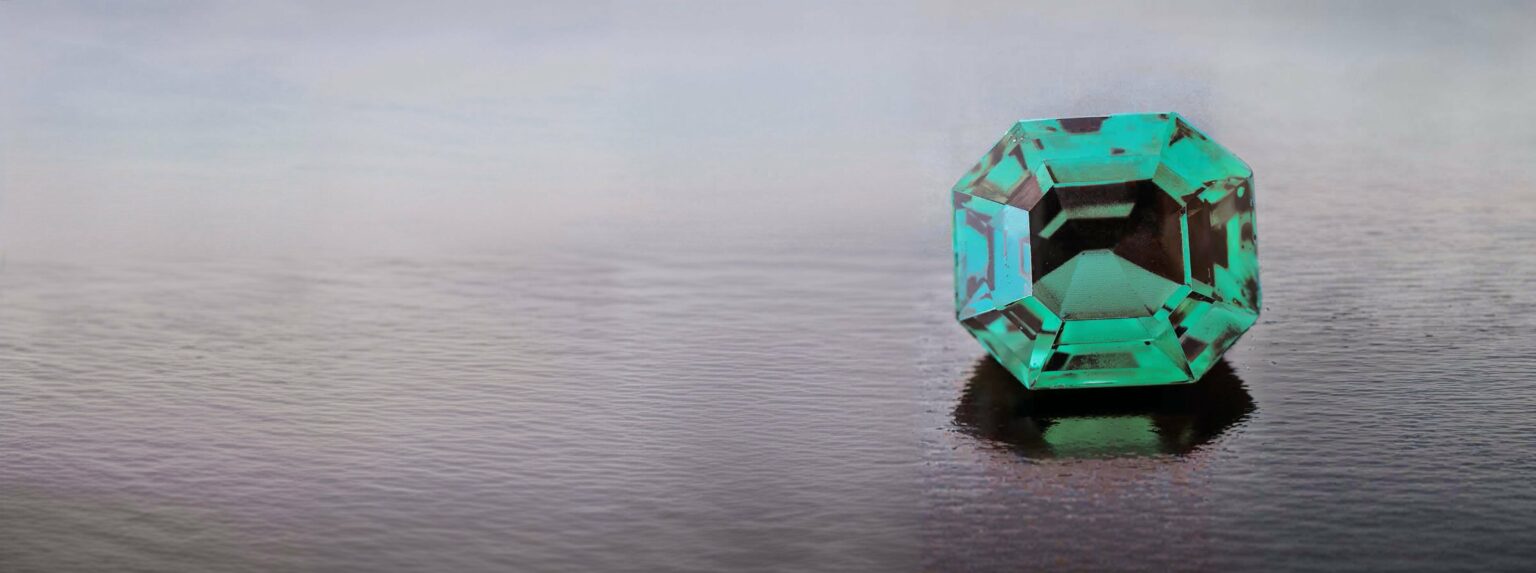Gem dealers are finding it harder than ever to make a plus of emerald’s greatest minus: its tendency to be highly included. And the ploy of calling the numerous wisps and veils of commercial Brazilian and Colombian stones something exotic like “jardins” (gardens) falls flat. What killed the acceptability of emeralds whose insides look like exploded cotton bolls?
Blame it on Zambia, the African country where in 1976 geologists discovered a radically different kind of emerald than that known for centuries. Roughs yielded stones so clean that dealers at first suspected they were synthetic with their stark, saturate greens that looked almost ominous next to Colombian emeralds sporting softer, sweeter hues.
The contrast between the two varieties of fine emerald triggered an immediate clash in the marketplace. At first, establishment dealers resisted the new material, but gradually viewed it, somewhat condescendingly, as a cheap alternative to high-priced Colombian goods. It took a group of intransigent outsiders, some of them from Israel and Afghanistan, to make the no-apologies-needed case for the new-breed beryl. In time, their uncompromising devotion to Zambian stones won the emerald enough approval to forge a double standard for emerald excellence.
But winning hearts and minds took time. Even some of the staunchest supporters of the African emerald harbored secret doubts about its aesthetic parity with Colombian material. Until only a few years ago, “I sold Zambian but preferred Colombian goods,” confesses African emerald specialist Kevin Kasdin, Kasdin and Bliss Inc., New York.
Because Zambian emerald has fostered radically higher expectations about mainstream emerald color and appearance that stones from other localities find it harder to fulfill, this material now has a strategic importance to the market, especially in its broad middle echelons. Indeed, when Zambian production faltered badly between 1982 and 1986, the entire emerald market suffered. It is probably no accident that the current boom in emerald sales coincides with a return to production levels in Zambia during 1987.
From Ebb to Flow
Until March of 1987, supplies of decent Zambian emerald, especially light and lively, medium-to-better 1- to 2-carat goods priced between $1,500 and $2,500 per carat, had been growing scarcer. In fact, as of January, dealers like Kasdin and Haim Aharanoff, M. Aharanoff Co., New York, were seriously worried about the future of Zambian emerald.
Then, in February 1987, word came from Israel that there would be significant quantities of decent-to-top-grade Zambian stones available once again. “Production has resumed in Zambia,” Israel Eliezri, Colgems Ltd., Tel Aviv, told us then. “Maybe it’s not as great as it was in 1980, but it’s enough to calm market fears.”
Eliezri underestimated the extent of Zambia’s new production. According to Kasdin, it equalled that of previous peak production years and has continued to do so. And despite prices that are 20% to 40% higher than in 1985, demand is brisk.
Why was supply of Zambian emerald sparse in the mid-1980s? Cutters in Israel attribute the dearth to politics. As Eliezri puts it rather delicately in 1986: “Zambia has been concentrating on taking control of mining.” To do this, it had to eliminate a powerful entrenched network of smugglers whose leaders operated out of Geneva, Switzerland. After jailing hundreds of suspected gem poachers and shooting at least eight of the most prominent Geneva-based contraband dealers, Zambia launched its own rough distribution company. At present, the government is selling its rough at periodic state-run auctions, the first of which was held in November 1985. It is material from this auction, much of it cut in Israel and India, that has been flowing into the U.S. market.
The Clamor for Clean
The disruption of goods from Zambia in the early and mid-1980s was so traumatic for the market that dealers still have a fingers-crossed attitude about future supply. Their fears are understandable. We hate to contemplate the effects of another drought.
While the ideal for color in emerald is still debatable, Zambian stones have allowed the jewelry market to savor aesthetic qualities never before associated with emerald, at least not man-on-the-street goods. “Jewelers don’t want to pay $1,000 per carat for 1-carat stones with open cracks,” says Doug Parker, of the William L. Kuhn Co., New York. “And, unfortunately, most Colombian stones in that price range have fissures that reach the surface.”
Instead, they want what Israel (and increasingly Zambian itself) has been giving: bright, clean stones with a glassy eye-popping appearance. “The jeweler has learned to see emerald through his customer’s eyes,” Aharonoff says. “Used to diamonds, they want colored stones with the same life to them, as well as color that jumps out.”
Luckily, Zambian emerald, more than any other variety, lent itself to a diamond cutter’s philosophy of precision beauty. In addition, the Israelis introduced emerald in a wide range of fancy shapes and offered them in calibrated sizes unavailable anywhere else. “By cutting with the large user in mind,” Kasdin says, “a manufacturer no longer had to make a mounting to fit the stone. Now he could expect stones to fit his mountings.”
Color Codes
Although Zambian emerald enjoys its widest acceptance ever, distinct color preferences have emerged for this variety—preferences which can mean a 100% to 150% difference in value between stones that are otherwise the same with regard to size, brilliance, clarity and cut.
When dealers talk about Zambian stones, they generally classify them into two basic color types: “blue tinge” and “yellow tinge.” The latter stones are far more valuable. For instance, popular-priced 1-carat Zambian emeralds with decent color, acceptable clarity and fair luster that veer toward blue will cost retailers $600 to $800 per carat; those that veer toward yellow command $1,000 to $1,200 per carat.
To get “yellow tinge” 1-carat stones in the hyperactive $500 to $700-per-carat sector, retailers will have to take duller-looking, more included stones. And at the high end of the quality spectrum, price differences are far vaster: $4,000 to $7,000 per carat for 1-carat stones. If that sounds steep, bear in mind that top-grade 1-carat Colombian emeralds fetch $10,000 to $12,000 per carat.
Please note: this profile was originally published in 1988 in Modern Jeweler’s ‘Gem Profiles: The First 60’, written by David Federman with photographs by Tino Hammid.
The 1.36-carat Zambian emerald shown in the header image is courtesy of Tuckman International, Seattle.






